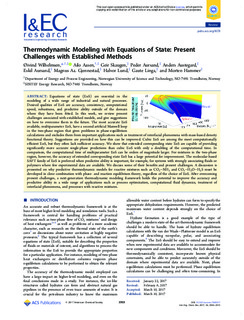| dc.contributor.author | Wilhelmsen, Øivind | |
| dc.contributor.author | Aasen, Ailo | |
| dc.contributor.author | Skaugen, Geir | |
| dc.contributor.author | Aursand, Peder | |
| dc.contributor.author | Austegard, Anders | |
| dc.contributor.author | Aursand, Eskil | |
| dc.contributor.author | Gjennestad, Magnus Aashammer | |
| dc.contributor.author | Lund, Halvor | |
| dc.contributor.author | Linga, Gaute | |
| dc.contributor.author | Hammer, Morten | |
| dc.date.accessioned | 2018-02-02T09:00:23Z | |
| dc.date.available | 2018-02-02T09:00:23Z | |
| dc.date.created | 2017-03-13T09:03:38Z | |
| dc.date.issued | 2017 | |
| dc.identifier.citation | Industrial & Engineering Chemistry Research. 2017, 56 (13), 3503-3515. | nb_NO |
| dc.identifier.issn | 0888-5885 | |
| dc.identifier.uri | http://hdl.handle.net/11250/2482318 | |
| dc.description.abstract | Equations of state (EoS) are essential in the modeling of a wide range of industrial and natural processes. Desired qualities of EoS are accuracy, consistency, computational speed, robustness and predictive ability outside of the domain where they have been fitted. In this work, we review present challenges associated with established models, and give suggestions on how to overcome them in the future. The most accurate EoS available, multiparameter EoS, have a second artificial Maxwell loop in the two-phase region that gives problems in phase-equilibrium calculations and exclude them from important applications such as treatment of interfacial phenomena with mass based density functional theory. Suggestions are provided on how this can be improved. Cubic EoS are among the most computationally efficient EoS, but they often lack sufficient accuracy. We show that extended corresponding state EoS are capable of providing significantly more accurate single-phase predictions than cubic EoS with only a doubling of the computational time. In comparison, the computational time of multiparameter EoS can be orders of magnitude larger. For mixtures in the two-phase region, however, the accuracy of extended corresponding state EoS has a large potential for improvement. The molecular-based SAFT family of EoS are preferred when predictive ability is important, e.g. for systems with strongly associating fluids or polymers where few experimental data are available. We discuss some of their benefits and present challenges. A discussion is presented on why predictive thermodynamic models for reactive mixtures such as CO2-NH3 and CO2-H2O-H2S must be developed in close combination with phase- and reaction equilibrium theory, regardless of the choice of EoS. After overcoming present challenges, a next-generation thermodynamic modeling framework holds the potential to improve the accuracy and predictive ability in a wide range of applications such as process optimization, computational fluid dynamics, treatment of interfacial phenomena and processes with reactive mixtures. | nb_NO |
| dc.language.iso | eng | nb_NO |
| dc.publisher | American Chemical Society | nb_NO |
| dc.title | Thermodynamic modeling with equations of state: present challenges with established methods | nb_NO |
| dc.type | Journal article | nb_NO |
| dc.type | Peer reviewed | nb_NO |
| dc.description.version | publishedVersion | nb_NO |
| dc.source.pagenumber | 3503-3515 | nb_NO |
| dc.source.volume | 56 | nb_NO |
| dc.source.journal | Industrial & Engineering Chemistry Research | nb_NO |
| dc.source.issue | 13 | nb_NO |
| dc.identifier.doi | 10.1021/acs.iecr.7b00317 | |
| dc.identifier.cristin | 1457656 | |
| dc.description.localcode | Copyright © 2017 American Chemical Society. This is an open access article published under an ACS AuthorChoice License, which permits copying and redistribution of the article or any adaptations for non-commercial purposes. | nb_NO |
| cristin.unitcode | 194,64,25,0 | |
| cristin.unitname | Institutt for energi- og prosessteknikk | |
| cristin.ispublished | true | |
| cristin.fulltext | original | |
| cristin.qualitycode | 2 | |
